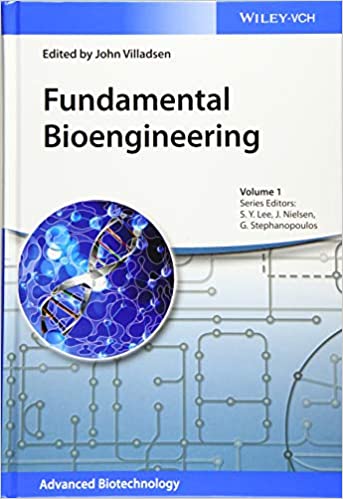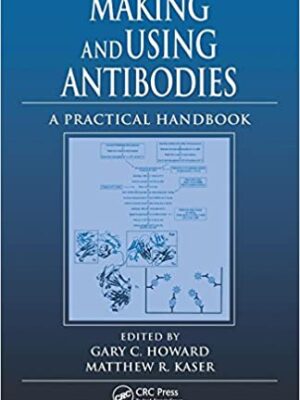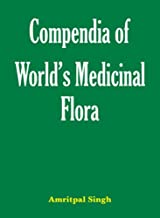Fundamental Bioengineering (Vol – 1)
Original price was: ₹16,462.90.₹13,170.32Current price is: ₹13,170.32.
ISBN: 9783527336746
Author/Editor: Villadsen
Publisher: John Wiley
Year: 2016
1 in stock (can be backordered)
Description
A thorough introduction to the basics of bioengineering, with a focus on applications in the emerging “white” biotechnology industry.
As such, this latest volume in the “Advanced Biotechnology” series covers the principles for the design and analysis of industrial bioprocesses as well as the design of bioremediation systems, and several biomedical applications. No fewer than seven chapters introduce stoichiometry, kinetics, thermodynamics and the design of ideal and real bioreactors, illustrated by more than 50 practical examples. Further chapters deal with the tools that enable an understanding of the behavior of cell cultures and enzymatically catalyzed reactions, while others discuss the analysis of cultures at the level of the cell, as well as structural frameworks for the successful scale-up of bioreactions. In addition, a short survey of downstream processing options and the control of bioreactions is given.
With contributions from leading experts in industry and academia, this is a comprehensive source of information peer-reviewed by experts in the field.
Additional information
| Weight | 1.374 kg |
|---|
Product Properties
| Year of Publication | 2016 |
|---|---|
| Table of Contents | List of Contributors xiii About the Series Editors xv 1 Introduction and Overview 1 John Villadsen Part One Fundamentals of Bioengineering 3 2 Experimentally Determined Rates of Bio-Reactions 5 John Villadsen Summary 5 2.0 Introduction 5 2.1 Mass Balances for a CSTR Operating at Steady State 7 2.2 Operation of the Steady-State CSTR 13 References 16 3 Redox Balances and Consistency Check of Experiments 17 John Villadsen Summary 17 3.1 Black-Box Stoichiometry Obtained in a CSTR Operated at Steady State 17 3.2 Calculation of Stoichiometric Coefficients by Means of a Redox Balance 20 3.3 Applications of the Redox Balance 23 3.4 Composition of the BiomassX 28 3.5 Combination of Black-Box Models 30 3.6 Application of Carbon and Redox Balances in Bio-Remediation Processes 34 References 38 4 Primary Metabolic Pathways and Metabolic Flux Analysis 39 John Villadsen Summary 39 4.0 Introduction 39 4.1 Glycolysis 43 4.2 Fermentative Metabolism: Regenerating the NAD+ Lost in Glycolysis 47 4.3 The TCA Cycle: Conversion of Pyruvate to NADH + FADH2, to Precursors or Metabolic Products 50 4.4 NADPH and Biomass Precursors Produced in the PP Pathway 56 4.5 Oxidative Phosphorylation: Production of ATP from NADH (FADH2) in Aerobic Fermentation 57 4.6 Summary of the Biochemistry of Primary Metabolic Pathways 59 4.7 Metabolic Flux Analysis Discussed in Terms of Substrate to Product Pathways 61 4.8 Metabolic Flux Analysis Discussed in Terms of Individual Pathway Rates in the Network 88 4.9 Propagation of Experimental Errors in MFA 94 4.10 Conclusions 96 References 96 5 A Primer to 13C Metabolic Flux Analysis 97 Wolfgang Wiechert, Sebastian Niedenfuhr, and Katharina Noh Summary 97 5.1 Introduction 97 5.2 Input and Output Data of 13C MFA 99 5.3 A Brief History of 13C MFA 101 5.4 An Illustrative Toy Example 102 5.5 The Atom Transition Network 104 5.6 Isotopomers and Isotopomer Fractions 104 5.7 The Isotopomer Transition Network 105 5.8 Isotopomer Labeling Balances 107 5.9 Simulating an Isotope Labeling Experiment 109 5.10 Isotopic Steady State 110 5.11 Flux Identifiability 112 5.12 Measurement Models 113 5.13 Statistical Considerations 114 5.14 Experimental Design 115 5.15 Exchange Fluxes 116 5.16 Multidimensional Flux Identifiability 118 5.17 Multidimensional Flux Estimation 120 5.18 The General Parameter Fitting Procedure 121 5.19 Multidimensional Statistics 123 5.20 Multidimensional Experimental Design 124 5.21 The Isotopically Nonstationary Case 127 5.22 Some Final Remarks on Network Specification 130 5.23 Algorithms and Software Frameworks for 13C MFA 132 Glossary 135 References 137 6 Genome-Scale Models 143 Basti Bergdahl, Nikolaus Sonnenschein, Daniel Machado, Markus Herrgard, and Jochen Forster Summary 143 6.1 Introduction 143 6.2 Reconstruction Process of Genome-Scale Models 144 6.3 Genome-Scale Model Prediction 147 6.3.1 Mathematical Description of Biochemical Reaction Systems 147 6.3.2 Constraint-Based Modeling 148 6.3.3 Pathway Analysis 148 6.3.4 Flux Balance Analysis 150 6.3.5 Engineering Applications of Constraint-Based Modeling 151 6.4 Genome-Scale Models of Prokaryotes 152 6.4.1 Escherichia Coli 153 6.4.2 Other Prokaryotes 156 6.4.3 Prokaryotic Communities 158 6.5 Genome-Scale Models of Eukaryotes 159 6.5.1 Saccharomyces Cerevisiae 160 6.5.2 Other Unicellular Eukaryotes 164 6.5.3 Other Multicellular Eukaryotes 166 6.6 Integration of Polyomic Data into Genome-Scale Models 169 6.6.1 Integration of Transcriptomics and Proteomics Data 170 6.6.2 Metabolomics Data 171 6.6.3 Integration of Multiple Omics 172 Acknowledgment 172 References 173 7 Kinetics of Bio-Reactions 183 John Villadsen Summary 183 7.1 Simple Models for Enzymatic Reactions and for Cell Reactions with Unstructured Biomass 184 7.2 Variants of Michaelis Menten and Monod kinetics 189 7.3 Summary of Enzyme Kinetics and the Kinetics for Cell Reactions 201 7.4 Cell Reactions with Unsteady State Kinetics 203 7.5 Cybernetic Modeling of Cellular Kinetics 211 7.6 Bioreactions with Diffusion Resistance 213 7.7 Sequences of Enzymatic Reactions: Optimal Allocation of Enzyme Levels 221 References 230 8 Application of Dynamic Models for Optimal Redesign of Cell Factories 233 Matthias Reuss Summary 233 8.1 Introduction 233 8.2 Kinetics of Pathway Reactions: the Need to Measure in a Very Narrow Time Window 235 8.2.1 Sampling 238 8.2.2 Quenching and Extraction 240 8.2.3 Analysis 241 8.2.4 Examples for Quantitative Measurements of Metabolites in Stimulus Response Experiments 242 8.3 Tools for In Vivo Diagnosis of Pathway Reactions 245 8.3.1 Modular Decomposition of the Network: the Bottom-Up Approach 247 8.4 Examples: The Pentose-Phosphate Shunt and Kinetics of Phosphofructokinase 247 8.4.1 Kinetics of the Irreversible Reactions of the Pentose-Phosphate Shunt 247 8.4.2 Kinetics of the Phophofructokinase I (PFK1) 252 8.5 Additional Approaches for Dynamic Modeling Large Metabolic Networks 256 8.5.1 Generalized Mass Action 259 8.5.2 S-Systems Approach 260 8.5.3 Convenience Kinetics 260 8.5.4 Log Lin and Lin Log Approaches 260 8.6 Dynamic Models Used for Redesigning Cell Factories. Examples: Optimal Ethanol Production in Yeast and Optimal Production of Tryptophan in E. Coli 268 8.6.1 Dynamic Model 269 8.6.2 Metabolic Control (Sensitivity) Analysis 270 8.6.3 Synthesis Amplification of Hexose Transporters 271 8.6.4 Objective Function 273 8.6.5 Optimal Solutions 275 8.6.6 Flux Optimization of Tryptophan Production with E. Coli 276 8.7 Target Identification for Drug Development 280 References 285 9 Chemical Thermodynamics Applied in Bioengineering 293 John Villadsen Summary 293 9.0 Introduction 293 9.1 Chemical Equilibrium and Thermodynamic State Functions 296 9.2 Thermodynamic Properties Obtained from Galvanic Cells 305 9.3 Conversion of Free Energy Harbored in NADH and FADH2 to ATP in Oxidative Phosphorylation 310 References 317 Part Two Bioreactors 319 10 Design of Ideal Bioreactors 321 John Villadsen Summary 321 10.0 Introduction 321 10.1 The Design Basis for a Once-Through Steady-State CSTR 322 10.2 Combination of Several Steady-State CSTRs in Parallel or in Series 329 10.3 Recirculation of Biomass in a Single Steady-State CSTR 332 10.4 A Steady-State CSTR with Uptake of Substrates from a Gas Phase 338 10.5 Fed-Batch Operation of a Stirred Tank Reactor in the Bio-Industry 340 10.6 Loop Reactors: a Modern Version of Airlift Reactors 349 References 355 11 Mixing and Mass Transfer in Industrial Bioreactors 357 John Villadsen Summary 357 11.0 Introduction 357 11.1 Definitions of Mixing Processes 358 11.2 The Power Input P Delivered by Mechanical Stirring 362 11.3 Mixing and Mass Transfer in Industrial Reactors 367 11.4 Conclusions 372 References 376 Part Three Downstream Processing 379 12 Product Recovery from the Cultures 381 Sunil Nath Summary 381 12.0 Introduction 381 12.1 Steps in Downstream Processing and Product Recovery 383 12.2 Baker s Yeast 383 12.3 Xanthan Gum 384 12.4 Penicillin 385 12.5 -A Interferon 386 12.6 Insulin 390 12.7 Conclusions 391 References 391 13 Purification of Bio-Products 393 Sunil Nath Summary 393 13.1 Methods and Types of Separations in Chromatography 394 13.2 Materials Used in Chromatographic Separations 396 13.3 Chromatographic Theory 398 13.4 Practical Considerations in Column Chromatographic Applications 399 13.5 Scale-Up 401 13.6 Industrial Applications 402 13.7 Some Alternatives to Column Chromatographic Techniques 403 13.8 Electrodialysis 403 13.9 Electrophoresis 404 13.10 Conclusions 407 References 407 Part Four Process Development, Management and Control 409 14 Real-Time Measurement and Monitoring of Bioprocesses 411 Bernhard Sonnleitner Summary 411 14.1 Introduction 411 14.2 Variables that should be Known 414 14.3 Variables Easily Accessible and Standard 415 14.4 Variables Requiring More Monitoring Effort and Not Yet Standard 422 14.4.1 Biomass 422 14.4.2 Products and Substrates 427 14.5 Data Evaluation 433 References 434 15 Control of Bioprocesses 439 Jakob Kjobsted Huusom Summary 439 15.1 Introduction 439 15.2 Bioprocess Control 440 15.2.1 Design Variables in Bioreactor Control 443 15.2.2 Challenges with Respect to Control of a Bioreactor 450 15.3 Principles and Basic Algorithms in Process Control 450 15.3.1 Open Loop Control 450 15.3.2 Feed-forward and Feedback Control 451 15.3.3 Single-Loop PID Control 452 15.3.4 Diagnostic Control Strategies 456 15.3.5 Plant-Wide Control Design 458 References 460 16 Scale-Up and Scale-Down 463 Henk Noorman Summary 463 16.1 Introduction 463 16.2 Description of the Large Scale 465 16.2.1 Mixing 468 16.2.2 Mass Transfer 472 16.2.3 CO2 Removal 475 16.2.4 Cooling 475 16.2.5 Gas Liquid Separation 476 16.3 Scale Down 480 16.3.1 One-Compartment Systems 482 16.3.2 Two-Compartment Systems 484 16.4 Investigations at Lab Scale 485 16.4.1 Gluconic Acid 485 16.4.2 Lipase 486 16.4.3 Baker s Yeast 488 16.4.4 Penicillin 490 16.5 Scale Up 491 16.6 Outlook 494 References 495 17 Commercial Development of Fermentation Processes 499 Thomas Grotkjaer Summary 499 17.1 Introduction 499 17.2 Basic Principles of Developing New Fermentation Processes 501 17.3 Techno-economic Analysis: the Link Between Science, Engineering, and Economy 506 17.3.1 Value Drivers and Production Costs of Fermentation Processes 506 17.3.2 Assessment of New Fermentation Technologies 519 17.3.3 Assessment of Competing Petrochemical Technologies 526 17.4 From Fermentation Process Development to the Market 528 17.4.1 The Value Chain of the Chemical Industry 530 17.4.2 Innovation and Substitution Patterns in the Chemical Industry 534 17.5 The Industrial Angle and Opportunities in the Chemical Industry 537 17.6 Evaluation of Business Opportunities 540 17.7 Concluding Remarks and Outlook 542 Acknowledgment 543 References 543 Index 547 |
| Author | Villadsen |
| ISBN/ISSN | 9783527336746 |
| Binding | Hardback |
| Edition | 1 |
| Publisher | John Wiley |
You must be logged in to post a review.






Reviews
There are no reviews yet.